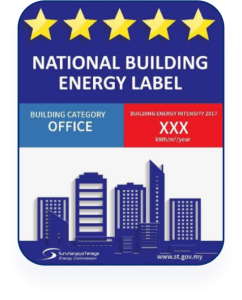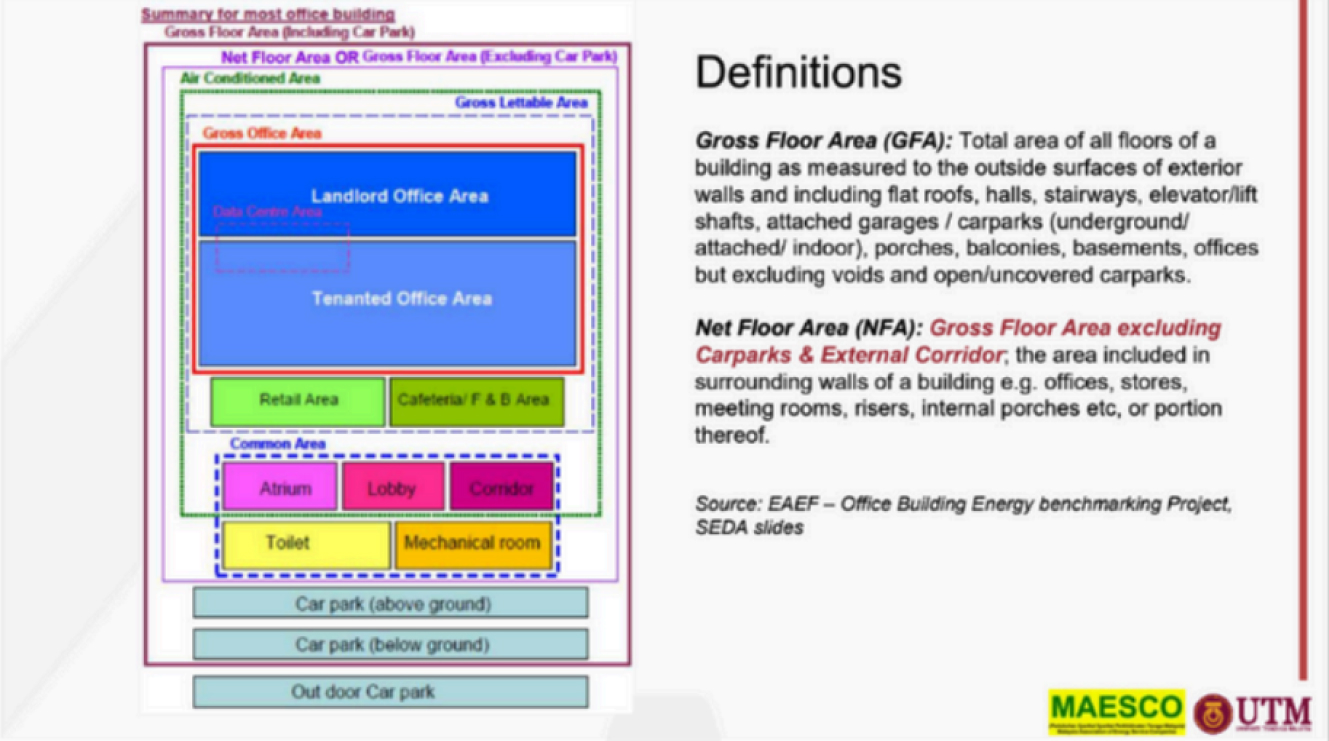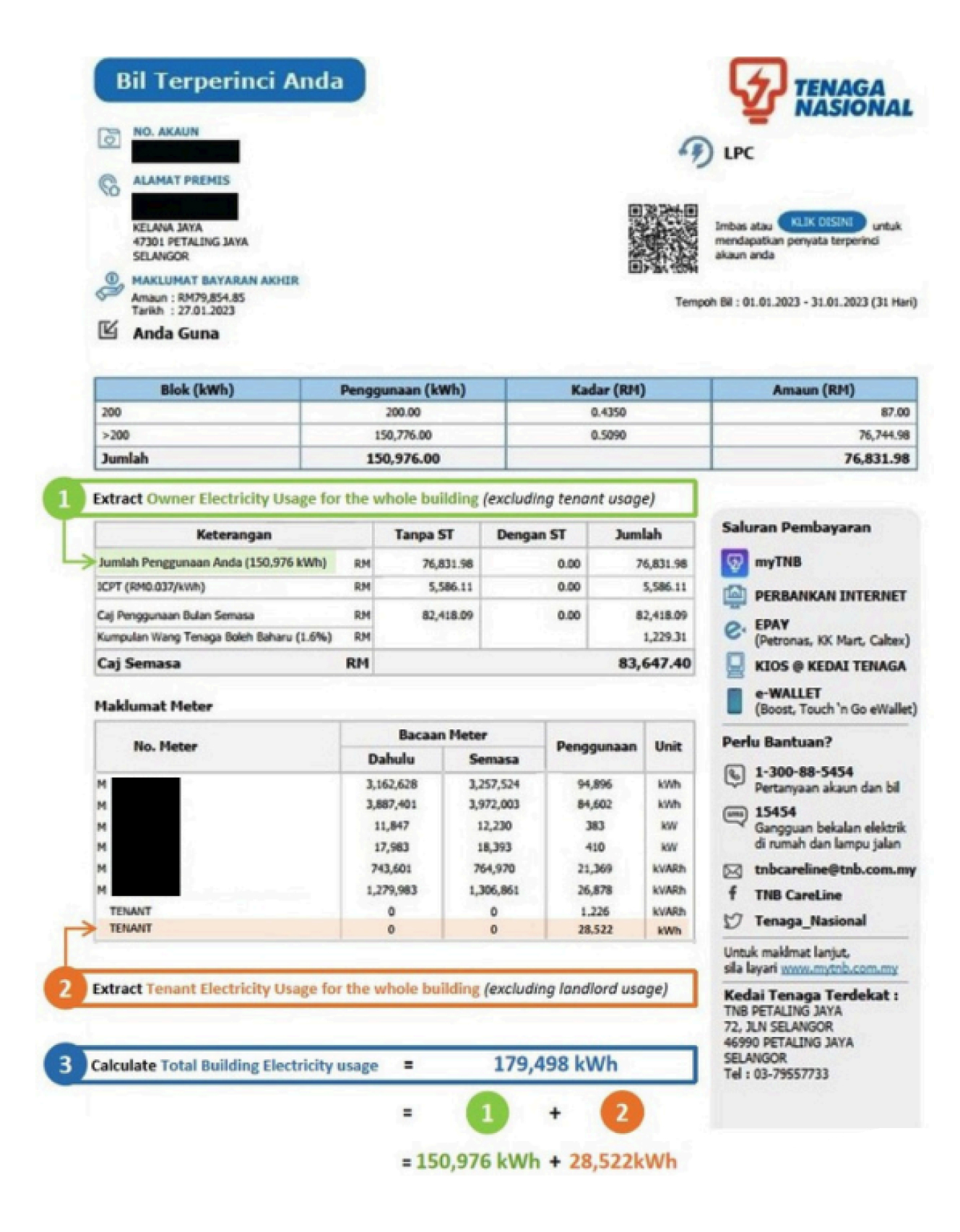Resources Center
Download Data Collection Sheet
BEI Data Collection
Office BEI Data Collection Sheet
Education Institutes BEI Data Collection Sheet
Healthcare Buildings BEI Data Collection Sheet
Download Others Resources
Others
Poster Image
Your Guide to Common Inquiries and Answers
Frequently Asked Questions (FAQ)
What is the difference between Building Energy Intensity and Building Energy Index?
Both “Intensity” and “Index” are similar. We prefer to use the keyword “Intensity” as a term used by the regulator which is Suruhanjaya Tenaga (ST). You may notice in the BEI Labelling released by ST is using the keyword ‘Intensity’; for consistency, this project adopts the same term.

Why are there few different versions of the BEI formula?
We are now using the preliminary BEI formula formulated by ST where the BEI is calculated by taking the ratio between annual energy consumption of a building (kWh/year) and nett floor area of the building (NFA).

Note that, the process of developing the BEI Label for the government office dated back to 2017/2018 when the definition of GFA and NFA were discussed in several sessions with the stakeholders and experts from KeTTHA (now PETRA), JKR, GBI, MGTC, KKM, FMM, UIAM, UiTM, SIRIM, etc.
The definitions of GFA and NFA by DBKL and MGTC have been taken into account to establish the GFA and NFA that are currently being used (and for EECA later) by ST in issuing the BEI Label. In addition, several options for BEI calculation tools also have been deliberated in the workshop.
For buildings with multiple owners, who each own a portion or unit within the building, who will be the responsible party for disclosing and collecting energy consumption data?
We are referring to ST regulation where the BEI must be calculated based on the whole building. In this case, we appreciate it if you could assist in collecting data from tenants of leased units. If you unable to access data from the tenants, you may answer the Section A (Related-sector Building Details) and Section B (Pre-assessment) only as per shown below and then you may submit the answered data collection sheet to aaibe.bei.secretariat@utm.my.
For example (Retail Building) as per shown below:

If we have about 3 buildings under our portfolio, should we submit these details in three separate forms?
Yes, you need to fill in energy consumption data for each of the 3 buildings separately in separate Data Collection Sheet Excel files.
What is the minimum targeted Star Rating should we get from this BEI project?
As per Energy Efficiency and Conservation Act (EECA), buildings labeled below 2 stars shall be required to conduct energy audits and submit improvement plans.
Does the calculation of NFA only account for the open area, excluding the space occupied by furniture within the room, including columns in the middle of the room? Or can it be included in the calculation as well?
The calculation of NFA (Net Floor Area) refers to the GFA (Gross Floor Area) excluding car parks and external corridors, which includes the area within the surrounding walls of the building, such as offices, storerooms, meeting rooms, internal balconies, and similar spaces, or a portion thereof. You may refer to the attachment below for detailed definition of building floor area as per regulated by ST.

Where should we submit the answered data collection sheet?
You may send the answered data collection sheet to aaibe.bei.secretariat@utm.my. You may contact +6075704842 if you have further inquiries.
Who initiated this project (is it the government or a university, etc.)?
The Ministry of Energy Transition and Water Transformation (PETRA) initiated the project to prepare stakeholders for the Energy Efficiency and Conservation Act (EECA). The project is Implemented by the regulator, The Energy Commission, with Universiti Teknologi Malaysia (UTM) and MAESCO as the consultants.
What would be the benefits of this project to the sector industry?
Here are the What’s in It For building owners (benefits) who participate in the Building Energy Intensity (BEI) Benchmarking Project:
- Access to the latest information on the EECA developments and requirements.
- Opportunities to contribute to the development of a localised and realistic BEI benchmarks and star rating systems that are suitable for the categories, designs, operations, and realities of the affected buildings, based on building owners’ inputs and feedback.
- Gain information and analytics on your building’s BEI label and potential improvement.
- Gain access to industry best practices on energy and cost savings measures for the affected buildings during the BEI benchmarking project.
- Enable early planning and preparation prior to the enforcement of EECA.
- Receive written recognition from PETRA and ST for the cooperation provided.
Is there any obligation for us to participate in this data collection or what if we do not participate?
PETRA has initiated this project to prepare stakeholders for mandatory compliance with Building Energy Labelling (BEL) under the EECA when it is due to be enacted, expectedly by 2025.
When the EECA is rolled out, it will be an obligation for building owners to comply. Specifically, it will be mandatory to display their BEL star rating based on the buildings‘ star-rating scheme that has been developed by then, with or without (inclusive) participation of the building owners and associations.
As we mentioned in the Whats-in-it-for Stakeholders, participation now at the stage of the development will provide the opportunity to influence and shape a localised star-rating scheme that can comfortably call its own. These are on top of other key expected benefits mentioned.
We feel that it is imperative for the associations and owners of the six types of buildings in Malaysia covered under this project to participate in order to avoid a situation whereby the star rating scheme enforced for a particular category of building is adapted from regional or global best practices.
Adaptation of BEL from other countries, especially from the developed ones may be quite common. However, these “imported” BELs tend to presume a higher baseline energy efficiency (EE) implementation standard, and therefore may not suit the local industries that are mostly at the starting point of EE implementation.
We readily have data on energy consumption and building floor area, but we anticipate quite some time in filling up energy-saving initiatives questions. Are energy-saving initiatives questions crucial to the success of this project?
Although answering questions about energy-saving initiatives is optional, it’s essential to understand their importance. Energy-saving initiatives done on the building are crucial to validate the rating of the building. For example, we can validate that the building receives a 5-star rating because they have taken certain measures to save energy and vice versa. Based on this question, the building’s management can also take note of which energy-saving initiatives they should focus on in order to raise their building rating and increase savings through the efficient usage of energy.
We need to sign an NDA before we can share the data of the buildings. Do you have an NDA prepared?
NDA will be sent together with the questionnaire unless you need to use your own NDA.
Which sectors of building are included in this project?
- Healthcare buildings
- Hotel
- Retail Buildings
- Data Centre
- Office Buildings
- Educational Institutions
Do we need to provide the utility provider and account number for all tenants in the Data Collection Sheet?
- No, tenants’ account numbers are not required. Only the utility provider and account number for the building owner are needed in the Data Collection Sheet.
We face difficulties on extracting building electricity consumption data as our buildings are quite complex with multiple tenants involved.
ST has provided several samples of typical TNB bills for tenanted buildings which show that the tenant’s electricity consumption data can also be extracted from the building owner’s TNB bill. You may follow the following steps to extract the whole building electricity usage inclusive the tenant usage from your TNB bill statement as a building owner:
- Extract Owner Electricity Usage for the whole building (excluding tenant usage)
- Extract Tenant Electricity Usage for the whole building (excluding owner usage)
- Calculate Total Building Electricity usage by summing up the extracted amounts from steps 2 and 3
You may refer to the attachment below for TNB bill sample guidelines.













